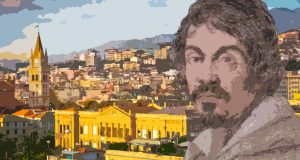“Arab-Norman Palermo and the Cathedral Churches of Cefalù and Monreale” is one of the seven UNESCO sites in Sicily. It was established in 2015 and includes seven landmarks in Palermo, plus Cefalù and Monreale Cathedrals.
The birth of Arab-Norman art
Arab-Norman architecture is a particular style of construction and decoration that emerged in Sicily during the 12th century. In 1072, Robert Guiscard and his brother Roger, members of the Altavilla family, conquered a large part of Sicily and Palermo. In the previous two centuries, the island had been ruled by three different dynasties from North Africa. The evolved Islamic culture had fostered exceptional development in the area, making Palermo a splendid city on a par with Cordoba, Jerusalem, Baghdad or Damascus. The new Norman rulers were won over by Islamic architectural styles and decided to exploit the expertise in the area in the construction of their own buildings. Arab craftsmen, skilled in the art of wood carving, and Byzantine mosaicists were used to create the interior decorations of the churches.
Characteristics of Arab-Norman art in Palermo
The Arab-Norman art that emerged in Palermo has specific characteristics. This style is the result of a perfect fusion of artistic influences from different cultures and religions. The structure of the buildings is composed of small square stone ashlars and the hemispherical domes that now characterise Palermo’s skyline began to appear. The vaults began to feature beautiful wooden ceilings carved with muqarnas by Arab craftsmen. On the exterior of the buildings, other decorations were inspired by the textures of fabrics typical of Fatimite culture. In fact, Roger II had a ‘tiraz’, a textile and goldsmith’s workshop, set up inside the Royal Palace. The emblem of Arab-Norman art in Palermo, however, remains the mosaics. The city’s own craftsmen were joined by others coming directly from Venice or Greece to create unparalleled golden masterpieces.
The UNESCO site: Arab-Norman Palermo and the Cathedral Churches of Cefalù and Monreale
In 2015, UNESCO decided to include nine landmarks amongst the World Heritage Sites, creating the itinerary called Arab-Norman Palermo and the Cathedral Churches of Cefalù and Monreale.
Palazzo dei Normanni and Cappella Palatina

An itinerary exploring Arab-Norman Palermo can only begin at the Palazzo Reale (Royal Palace). The building is also called Palazzo dei Normanni because the Normans made it their residence from 1072 onwards. Under the Altavilla family, the palace became famous throughout Europe for its architectural and decorative richness. On the first floor of the building, there is a place that is an authentic manifesto of Arab-Norman art in Palermo: the Cappella Palatina (Palatine Chapel). In this space, we find all the typical elements of this artistic trend. The wooden ceiling of the nave has fine inlaid muqarnas and paintings depicting animals and dancers. On the floor, marble inlays echo the star pattern and are laid out like a carpet, in a geometric distribution that mirrors that of the ceiling. The walls and apse are covered with golden mosaics depicting episodes from the Old and New Testaments.
Church of San Giovanni degli Eremiti

If the Cappella Palatina is the manifesto of Arab-Norman art in Palermo, the pink domes of the Church of San Giovanni degli Eremiti are another undisputed icon of the UNESCO itinerary. It is a splendid example of a Christian building that was built according to Islamic architectural designs. The church’s appearance is a result of the cubic and spherical shape of the domes. It draws on the shapes of the circle and the square which, in Fatimite and Byzantine art, symbolise earth and sky. Initially, the complex was a Gregorian monastery built between 1130 and 1142 on the orders of Roger II. It included, in addition to the church and cloister, a dormitory, a refectory and a cemetery, which no longer exist. The shape of the Church of San Giovanni degli Eremiti’s cloister foreshadows that of Monreale Cathedral. An oriental scent pervades its vegetation.
Palermo Cathedral

Continuing the itinerary for discovering Arab-Norman art in Palermo means moving on to the Quattro Canti, the city’s centre of gravity. First, however, we come to another very important building: Palermo Cathedral. The present structure is the result of a major reconstruction in 1169. Under Arab rule, the building was formerly a mosque. Verses from the Quran are still engraved on a column in the southern portico. The church today is a fusion of different architectural styles, the result of various renovations over the centuries. Catalan Gothic, Baroque and Neoclassical elements can be recognised. Some parts of the original Norman church can be made out on the eastern façade at the apse, with inlaid lava stone decoration of Fatimite cultural origin, which, in the alternation of geometric, floral and animal motifs, picks up on some typical designs from its textile art. Inside the right aisle are the ‘Royal Tombs’.
Church of San Cataldo

Following Via Maqueda and passing the Fontana Pretoria, we encounter two more buildings on the Arab-Norman Palermo itinerary. The first is the Church of San Cataldo, where we find the same geometry as the Church of San Giovanni degli Eremiti. Once inside, one is certainly struck by the contrast between the simplicity of the bare walls and the richness of the floor. This is made of opus sectile, a very ancient technique that produces inlaid patterns using marble or other materials. The interior of the Church of San Cataldo is divided into three naves by columns with capitals supporting their pointed arches. In the central nave, there is a marble altar engraved with a Greek cross and the symbols of the four Evangelists.
Chiesa della Martorana (or Admiral’s Church)

Right next to the Church of San Cataldo is the other Arab-Norman building: the Chiesa della Martorana or Chiesa dell’Ammiraglio (Admiral’s Church). It is an extraordinary building, which tells the story of nine centuries of Sicilian art and culture. The central area of the church, which is the oldest part, is decorated with mosaics depicting the life of the Virgin. They were made between 1143 and 1148 by Arab craftsmen who came specially from the East. The vaults feature 18th-century frescoes by painters, Olivio Sozzi, Antonio Grano and Guglielmo Borremans. The floor is in marble with splendid opus sectile decoration. The Chiesa della Martorana also contains a splendid 12th-century wooden portal with carvings by Arab craftsmen. This Palermo church is also very famous for another reason. The Basilian nuns in the Martorana monastery, of which the church was a part, invented one of Sicily’s most famous sweets, called ‘frutta martorana’.
Palazzo della Zisa

Moving away from Palermo’s centre, you can visit the Palazzo della Zisa, the best-preserved example of Islamic culture in Sicily. This was the summer residence of the Norman kings and here they devoted themselves to rest and recreation. The name comes from the Arabic Al-Azīz, meaning ‘the glorious’ or ‘the splendid’. Construction of the Zisa was begun in 1165 by King William I and completed by his son William II between 1165 and 1180. The building has a rectangular layout and is on three different floors. The most fascinating room in the entire Palazzo della Zisa is the Sala della Fontana (Fountain Room). Several typically Islamic architectural elements are identifiable here. The hall itself is a metaphorical representation of one of the waterways of Islamic paradise. The Castello della Zisa is also home to the Palermo Museum of Islamic Art. It brings together art from the 9th and 12th centuries originating from Sicily and various Mediterranean countries.
Ponte dell’Ammiraglio

The last Arab-Norman landmark on the UNESCO itinerary in Palermo is the Ponte dell’Ammiraglio (Admiral’s Bridge). It is so called because it was Admiral George of Antioch who commissioned its construction. It is a splendid example of medieval civil engineering, built with neatly squared ashlars of tufa stone. It has a simple ‘humpback’ structure, with seven oval arches, alternating with five smaller arches built into the pillars. Until 1938, the Oreto river flowed under the arches of the bridge, but was then diverted due to constant flooding. On 27 May 1860, Garibaldi’s troops clashed with the Bourbons on this bridge during the Expedition of the Thousand. The scene was depicted by the painter, Renato Guttuso, in one of his most famous paintings called The Battle of Admiral’s Bridge.
Cefalù Cathedral

Cefalù Cathedral
In less than an hour by train from Palermo, or just over an hour by car, it is possible to reach Cefalù, a splendid town that has been included in the tour of Italy’s most beautiful towns. The Cathedral of Cefalù is also part of the UNESCO site for Arab-Norman Palermo and when you see its interior, you will understand why. The apse is decorated with an impressive Byzantine-style mosaic of a Christ Pantocrator, depicted blessing with only three fingers of his right hand, following the Greek tradition. Other mosaics can be found on the walls of the presbytery and the vault. The beauty of these decorative elements is enhanced by the light filtering through the thirty-two stained glass windows, created in the 1990s by the artist, Michele Canzonieri. The north aisle of Cefalù Cathedral leads to the Norman cloister with its twin columns and sculpted capitals. In 1809, a fire destroyed the east aisle, whereas the north, south and west aisles were saved.
Monreale Cathedral

The last monument that is part of the Arab-Norman Palermo UNESCO site is the Cathedral of Monreale. Construction of this cathedral began around 1172 on the orders of William I, who wanted to create a mausoleum for his dynasty (the Altavilla). However, it was not until 1267 that construction was completed. The typical features of Arab-Norman art can already be discerned on the outside in the area of the apses. Here, as in Palermo Cathedral, there are decorative textures inspired by Fatimite textile art. Once inside, you will not fail to be delighted. The interior walls of the church are covered with 6,400 square metres of golden mosaics. The scenes depicted are taken from the Old and New Testaments and the Acts of the Apostles. This impressive piece of art was realised between 1180 and 1190 by workers who came all the way from Constantinople and Greece. These mosaicists were joined by Muslim, Venetian and local workers.
The other Arab-Norman landmarks in Palermo
In addition to the nine landmarks that are officially part of the UNESCO World Heritage Site, there are other examples of Arab-Norman art. These are churches, castles and civil buildings that are not currently World Heritage Sites but may be added to the itinerary in the future. In the city of Palermo these are: La Cuba; the Church of San Giovanni dei Lebbrosi; La Cuba Soprana; La Piccola Cuba; the Church of Santa Maria Maddalena; the Castello di Maredolce; the Cappella di Santa Maria dell’Incoronata; the Church of Santa Cristina la Vetere; the Castello dell’Uscibene; Castello a Mare; the Chiesa di Santo Spirito; and the Chiesa della Santissima Trinità alla Zisa or della Magione. In the small village of Cefalà Diana, about an hour’s drive from Palermo, are the Bagni di Cefalà (Cefalà Baths).





